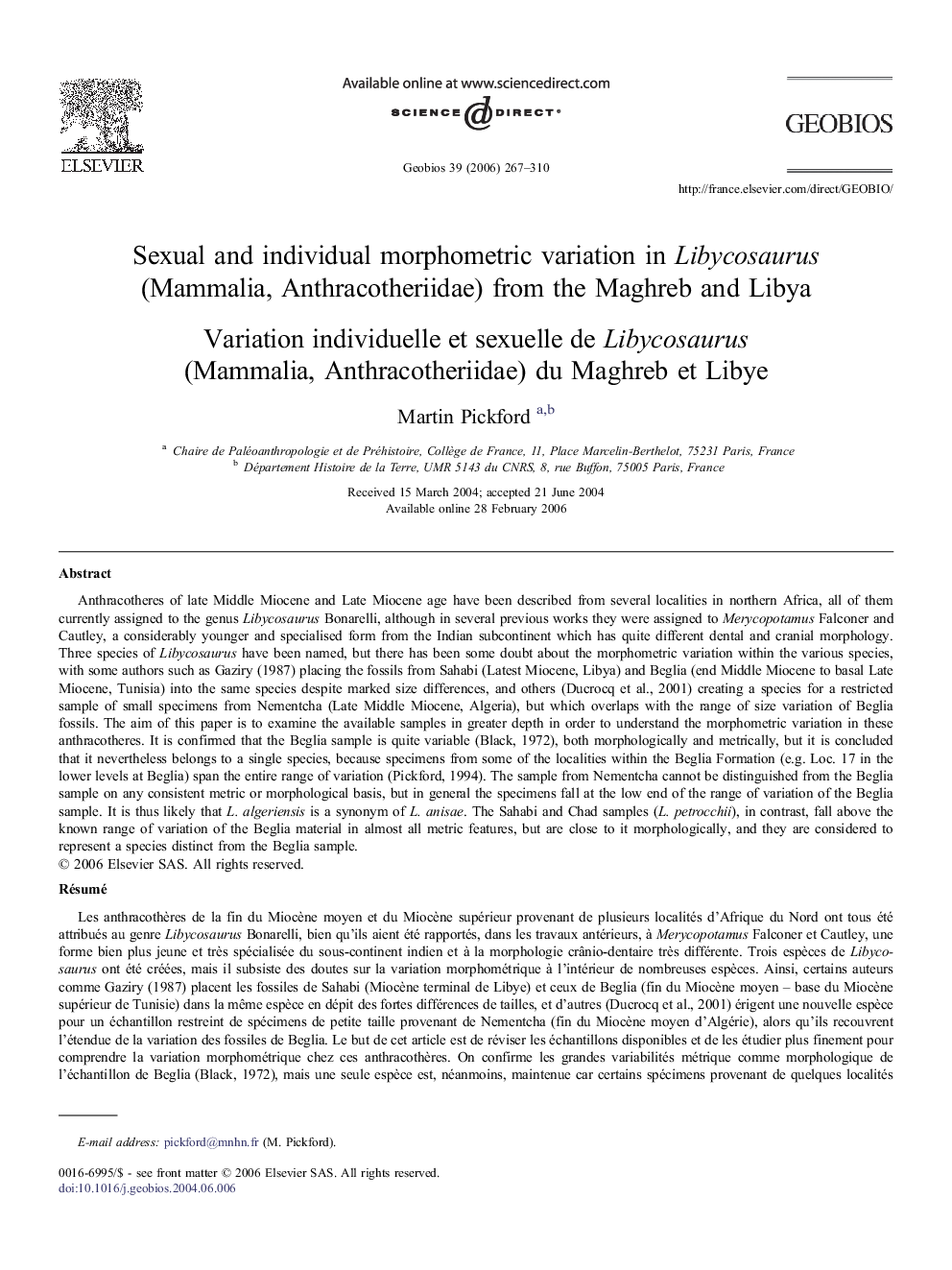| کد مقاله | کد نشریه | سال انتشار | مقاله انگلیسی | نسخه تمام متن |
|---|---|---|---|---|
| 4748655 | 1360131 | 2006 | 44 صفحه PDF | دانلود رایگان |

Anthracotheres of late Middle Miocene and Late Miocene age have been described from several localities in northern Africa, all of them currently assigned to the genus Libycosaurus Bonarelli, although in several previous works they were assigned to Merycopotamus Falconer and Cautley, a considerably younger and specialised form from the Indian subcontinent which has quite different dental and cranial morphology. Three species of Libycosaurus have been named, but there has been some doubt about the morphometric variation within the various species, with some authors such as Gaziry (1987) placing the fossils from Sahabi (Latest Miocene, Libya) and Beglia (end Middle Miocene to basal Late Miocene, Tunisia) into the same species despite marked size differences, and others (Ducrocq et al., 2001) creating a species for a restricted sample of small specimens from Nementcha (Late Middle Miocene, Algeria), but which overlaps with the range of size variation of Beglia fossils. The aim of this paper is to examine the available samples in greater depth in order to understand the morphometric variation in these anthracotheres. It is confirmed that the Beglia sample is quite variable (Black, 1972), both morphologically and metrically, but it is concluded that it nevertheless belongs to a single species, because specimens from some of the localities within the Beglia Formation (e.g. Loc. 17 in the lower levels at Beglia) span the entire range of variation (Pickford, 1994). The sample from Nementcha cannot be distinguished from the Beglia sample on any consistent metric or morphological basis, but in general the specimens fall at the low end of the range of variation of the Beglia sample. It is thus likely that L. algeriensis is a synonym of L. anisae. The Sahabi and Chad samples (L. petrocchii), in contrast, fall above the known range of variation of the Beglia material in almost all metric features, but are close to it morphologically, and they are considered to represent a species distinct from the Beglia sample.
RésuméLes anthracothères de la fin du Miocène moyen et du Miocène supérieur provenant de plusieurs localités d'Afrique du Nord ont tous été attribués au genre Libycosaurus Bonarelli, bien qu'ils aient été rapportés, dans les travaux antérieurs, à Merycopotamus Falconer et Cautley, une forme bien plus jeune et très spécialisée du sous-continent indien et à la morphologie crânio-dentaire très différente. Trois espèces de Libycosaurus ont été créées, mais il subsiste des doutes sur la variation morphométrique à l'intérieur de nombreuses espèces. Ainsi, certains auteurs comme Gaziry (1987) placent les fossiles de Sahabi (Miocène terminal de Libye) et ceux de Beglia (fin du Miocène moyen – base du Miocène supérieur de Tunisie) dans la même espèce en dépit des fortes différences de tailles, et d'autres (Ducrocq et al., 2001) érigent une nouvelle espèce pour un échantillon restreint de spécimens de petite taille provenant de Nementcha (fin du Miocène moyen d'Algérie), alors qu'ils recouvrent l'étendue de la variation des fossiles de Beglia. Le but de cet article est de réviser les échantillons disponibles et de les étudier plus finement pour comprendre la variation morphométrique chez ces anthracothères. On confirme les grandes variabilités métrique comme morphologique de l'échantillon de Beglia (Black, 1972), mais une seule espèce est, néanmoins, maintenue car certains spécimens provenant de quelques localités situées dans la Formation de Beglia (e.g. Loc. 17 des niveaux inférieurs de Beglia) recouvrent toute l'étendue de la variation (Pickford, 1994). L'échantillon de Nementcha ne peut être distingué de celui de Beglia métriquement et morphologiquement, mais les spécimens se placent généralement à la base de la variation de Beglia. Il semble donc probable que L. algeriensis soit un synonyme de L. anisae. En revanche, les fossiles de Sahabi et du Tchad (L. petrocchii) se placent au-dessus de la variation de l'échantillon de Beglia dans pratiquement toutes les mensurations, mais sont proches morphologiquement. On les considère comme appartenant à une espèce distincte de celle de Beglia.
Journal: Geobios - Volume 39, Issue 2, March–April 2006, Pages 267–310